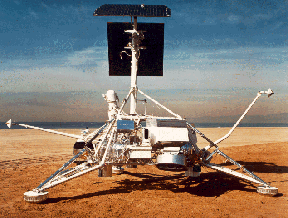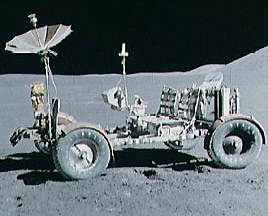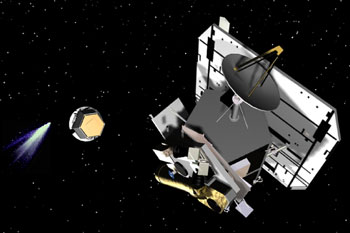Picture of Apollo 12 lunar module
NASA
Apollo 12
Apollo 12 survived a lightning strike during its launch on Nov. 14, 1969, and arrived at the Moon three days later. Astronauts Charles Conrad and Alan Bean descended to the surface, while Richard Gordon remained in lunar orbit aboard the Command Module.
Computers accurately guided the Lunar Module to a landing site in the Ocean of Storms, close to that of the Surveyor 3 probe which had landed on the Moon two years earlier. The astronauts each performed two EVA's, during which they collected soil and rock samples, and recovered parts of the Surveyor spacecraft for further study. Scientists back on Earth were very interested in learning how long-term exposure to the lunar environment had affected their equipment, with plans for a lunar base in the distant future.
The astronauts also deployed a lunar surface experiments package which would measure seismic and magnetic activity on the Moon.
The Apollo 12 mission was a complete success but unfortunately was not seen by audiences back on Earth. Its television camera broke during the first few minutes on the Moon, after direct exposure to the Sun's intense radiation.
You might also be interested in:

The Surveyor missions of 1966 through 1968 were the next step in space travel to the Moon, following the Ranger missions. Their goal was to perform "soft" landings on the lunar surface, meaning that the
...more
The Hubble Space Telescope (HST) was one of the most important exploration tools of the past two decades, and will continue to serve as a great resource well into the new millennium. The HST is credited
...more
Driven by a recent surge in space research, the Apollo program hoped to add to the accomplishments of the Lunar Orbiter and Surveyor missions of the late 1960's. Apollo 11 was the first mission to succeed
...more
Apollo 12 survived a lightning strike during its launch on Nov. 14, 1969, and arrived at the Moon three days later. Astronauts Charles Conrad and Alan Bean descended to the surface, while Richard Gordon
...more
Apollo 15 marked the start of a new series of missions from the Apollo space program, each capable of exploring more lunar terrain than ever before. Launched on July 26, 1971, Apollo 15 reached the Moon
...more
NASA chose Deep Impact to be part of a special series called the Discovery Program on July 7, 1999. In May 2001, Deep Impact was given the "go" from NASA to start with mission development. Deep Impact
...more
The Galileo spacecraft was launched on October 19, 1989. Galileo had two parts: an orbiter and a descent probe that parachuted into Jupiter's atmosphere. Galileo's primary mission was to explore the Jovian
...more














